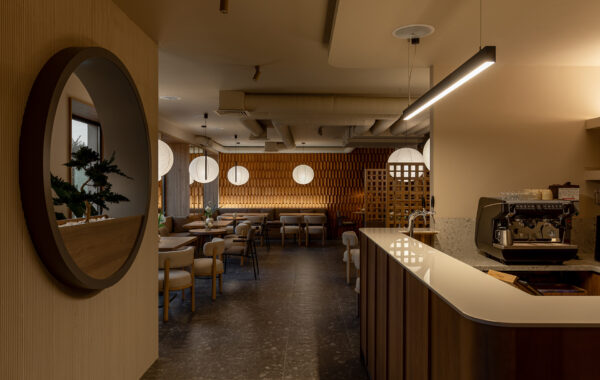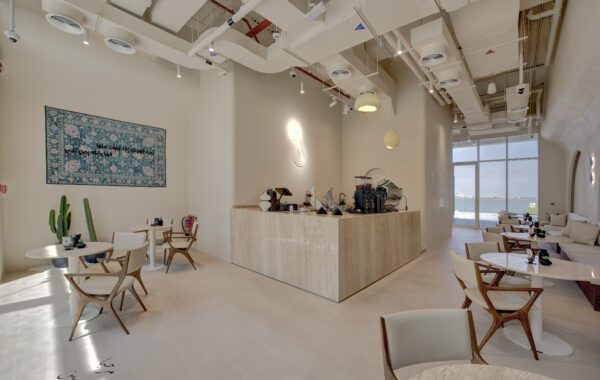
Selecting The Perfect Restaurant Furniture
Choosing the right furniture for your restaurant is a crucial step in creating a welcoming and comfortable dining environment for your customers. From chairs and tables to décor and interior style, each element plays a vital role in shaping the overall ambiance and experience.
Whether you’re a seasoned restaurateur or embarking on a new culinary venture, understanding the nuances of restaurant furniture selection will ensure that your establishment stands out in the vibrant dining experience.
In this comprehensive guide, we’ll explore the importance of restaurant furniture, the different types of furniture you can choose, and essential considerations for selecting the perfect pieces that align with your restaurant’s vision and space constraints.
Table of Contents
Importance of Restaurant Furniture
What is the role of Furniture in a Restaurant?
What Are the Advantages of Furniture in a Restaurant?
Why are Chairs Important at a Restaurant?
How Long Does Restaurant Furniture Last?
How to Choose Furniture for a Restaurant?
What is the height of restaurant furniture?
What is the best size table for a restaurant?
How wide are restaurant tables?
What is the size of a restaurant chair?
Importance of Restaurant Furniture
The right furniture set is crucial for the best dine-in experience. It is the first element a customer notices when entering a restaurant. Furniture plays a big role in how a customer feels and what they think about the place.
The importance of furniture in a restaurant goes beyond just its functionality. It should aid the comfort of the customer and add to the ambiance as well as the aesthetic of the restaurant which will help attract customers.
Good restaurant furniture is comfortable to sit on and also adds to the overall atmosphere of the place. Imagine sitting in a cozy booth with soft cushions and dim lighting versus sitting on a hard chair under bright lights.
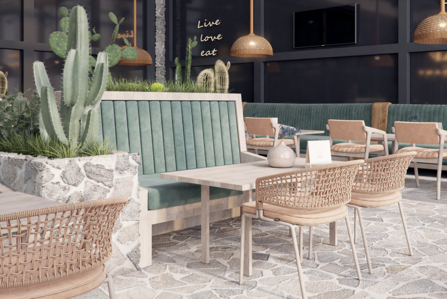
The right furniture can make you feel relaxed and happy, while the wrong furniture can make you feel uncomfortable and eager to leave.
Plus, the way the furniture looks can say a lot about the restaurant itself. Sleek, modern furniture might suggest a trendy, upscale place, while rustic wooden tables and chairs might give off a more casual, homey vibe. So, not only does the furniture need to be comfortable and functional, but it also needs to match the restaurant’s style and brand personality.
What is the role of Furniture in a Restaurant?
Different restaurants feature different styles of furniture to cater to the dining experience they desire to offer.
Restaurants have a variety of dining table sizes, ranging from small to huge, to accommodate smaller to larger groups. Similarly, seating styles can range from establishing a traditional look to just providing a comfortable space for customers to eat in.
Successful restaurants understand that creating the right dining experience involves considering the needs and preferences of their customers. That’s why they often feature different styles of furniture to match the ambiance and atmosphere they want to create.
For instance, some restaurants might opt for sleek, modern furniture with clean lines and minimalistic designs to convey a sense of sophistication and contemporary flair. Others might prefer rustic or vintage-inspired furniture to evoke a cozy, nostalgic atmosphere.
Moreover, having a variety of dining table sizes is essential to accommodate different group sizes. Smaller tables are perfect for couples or solo diners, while larger tables or communal seating arrangements cater to bigger groups or families.
Seating styles also play a crucial role in shaping the overall dining experience. Some restaurants might choose traditional seating arrangements, such as booths or banquettes, to provide a sense of privacy and intimacy. Others might prioritize comfort by offering plush chairs or even lounge-style seating for a more relaxed atmosphere.
Ultimately, the variety of furniture styles, table sizes, and seating options allows restaurants to tailor the dining experience to the preferences of their customers, ensuring that everyone feels comfortable and welcome.
What Are the Advantages of Furniture in a Restaurant?
Selecting well-suited and intelligently planned furniture offers several advantages that contribute to the overall dining experience.
Quality furniture enriches the place’s visual appeal and ambiance. A venue with excellent interior design draws more clients, particularly young adults, who also help to promote your restaurant through social media and word of mouth.
In addition to this, comfortable seating arrangements are more likely to satisfy customers because they will enjoy the meal more, will prefer to stay longer, and most likely become repeat clients.
Furthermore, the choice of furniture is critical for establishing a desired style and contributing to the restaurant’s identity. It doesn’t matter what type or design the furniture is; it adds value and helps to portray the restaurant’s identity.
A well-furnished and visually striking restaurant is one of the most important factors that customers consider when choosing where to dine. Hence, the best set of furniture enables the restaurant to attract more customers. Good feedback and word-of-mouth recommendations have an impact on people, encouraging them to visit the restaurant.
Why are Chairs Important at a Restaurant?
Chairs play a crucial role in shaping the dining experience at a restaurant for several reasons.
First, they are visual elements that contribute significantly to the overall aesthetic appeal of the establishment. The style and design of the chairs make a powerful first impression on customers, influencing their perception of the restaurant and its brand identity. By selecting chairs that align with the restaurant’s theme and personality, owners can create a cohesive and visually appealing dining environment.
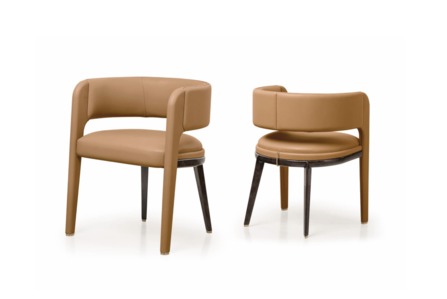
Moreover, beyond their visual impact, chairs serve a practical function by providing a comfortable seating option for customers. Comfortable seating encourages guests to relax and enjoy their meal, enhancing their overall dining experience. When patrons feel at ease, they are more likely to prolong their stay, potentially leading to increased orders and higher revenue for the restaurant. Therefore, investing in high-quality and ergonomic chairs is essential for ensuring customer satisfaction and maximizing business success.
If you’re not sure what kind of chairs you should select for your restaurant or cafe, consider consulting a restaurant interior designer company.
How Long Does Restaurant Furniture Last?
The lifespan of your restaurant’s furniture depends on various factors. This includes the durability of the furniture, the type and material, and the usage of the furniture.
To emphasize, high-quality and durable material such as metal and hardwood lasts up to 10 years.
The key point is to take care of your furniture to make it last long. You can do that by regular cleaning, refurbishments, and proper maintenance. For instance, if you have an outdoor seating arrangement, your furniture is bound to catch dust and dirt all day long. Therefore, it’s important to clean them thoroughly at the end of the day before locking up.
How to Choose Furniture for a Restaurant?
Choosing furniture for your restaurant? Keep the following aspects in mind:
-
Restaurant Furniture Material
The furniture material you choose should be durable and easy to maintain. Here are some suggestions:
- Metal: Metal furniture, such as aluminum or iron, is famous for its flexibility and sturdiness. It proves to be a good choice for outdoor seating and supports heavy use. Metal is easy to clean and is even pest-resistant due to its hostility to moisture. However, metal does not always support the comfort of the customers and does not give a “cozy” vibe.
- Wood: Wood is a classic choice for restaurant furniture due to its timeless attraction and sturdiness. Hardwoods like oak maple and walnut are great choices because they prove to be durable and perfect for overuse. Wooden furniture gives your restaurant a warm and welcoming look. However, wooden furniture requires high maintenance. It’s prone to scratching and easily locks in moisture, inviting pests. It requires regular cleaning and maintenance.
- Laminate: Laminated furniture is a popular choice due to its immense durability which allows it to last up to 12 years. It’s scratch-resistant, moisture-resistant, and easily maintainable, making it suitable for a busy place like a restaurant. Laminate is also available in various colors and designs, which makes it essential for creating themes and designs for your restaurant. However, laminate can chip or peel after a certain period, especially if exposed to heat.
- Plastic: Another choice for restaurant furniture material is plastic. Lightweight and usually very affordable, plastic furniture is easy to clean and maintain and is often the top choice for outdoor arrangements. Plastic is also available in many colors and designs offering you a wide variety of options. However, plastic is not as durable and can be easily broken. It also doesn’t offer you the same aesthetic as other materials and can only be suitable for casual dining.
- Glass: Glass furniture is the epitome of grace and elegance. It offers a lavish look to your restaurant’s interior. Glass is also easy to clean and extremely low maintenance but can chip off if not taken care of. However, glass furniture is comparatively expensive and may exceed your budget limit.
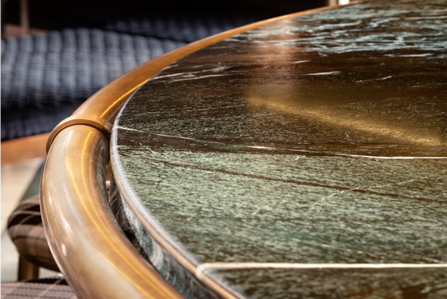
-
Restaurant Furniture Measurement
When intricately planning furniture shopping for your restaurant, you can’t be random with the size and measurements. It’s crucial to take into account height, width, etc. to ensure comfortable seating and spacious movement.
-
What is the height of restaurant furniture?
The height is extremely important to ensure the comfort of the customers. Standard dining tables have an ideal height of around 30 inches, which lets the customers sit comfortably without feeling too low or high. Chairs have a seat height of around 18 inches. This height maintains a proper ergonomic alignment.
-
What is the best size table for a restaurant?
The best size for a restaurant table depends on the space you have available in your restaurant. You can work with the space you have to create a desirable dining experience. However, generally, small spaces have tables that are 24-inch wide and 30-inch tall. Large spaces sometimes have tables with 30 to 36 inches of width.
The type of cuisine you’re offering, the dining atmosphere you are trying to create, and the space you have are important factors when considering sizes.
-
How wide are restaurant tables?
Smaller tables at a restaurant are around 24 inches wide. These tables create cozy setups and allow for intimate conversations. For large parties, you can have a few 30 to 36-inch wide tables as well. These large tables allow communal dining for customers without making them feel cramped.
-
What is the size of a restaurant chair?
Comfort and support are crucial throughout the meals, which makes chairs a critical piece of furniture in a restaurant. The standard width for a restaurant chair is around 16 to 18 inches, allowing sufficient space and comfort. Moreover, the backrest should be 32 to 36 inches high to provide optimal support.
-
Restaurant Furniture Shape
From tables to chairs, the choice of shapes can influence the overall design, traffic flow, and the dining experience.
- Table Shapes: The shape of restaurant tables contributes significantly to the overall layout and aesthetics. Round tables foster a sense of intimacy and encourage conversation, making them ideal for smaller groups. Square and rectangular tables, on the other hand, are more space-efficient and can be arranged to accommodate larger parties or optimize floor space. The choice between round and rectangular tables often depends on the size of the dining area and the desired atmosphere.
- Chair Shapes: The shape of restaurant chairs not only affects the visual appeal but also influences comfort. Traditional wooden chairs with slatted or upholstered backs convey a classic and timeless look, while more modern designs may feature sleek lines and geometric shapes. The curvature of the backrest and seat should also be considered, as it directly impacts the ergonomic support provided to customers.
- Booths and Banquettes: Booths and banquettes offer a unique seating option in restaurants, providing comfort and privacy for diners. The shape of these built-in seating arrangements can vary from straight lines to curved designs, allowing for customization based on the available space and desired aesthetic. Curved booths, for example, create a cozy and intimate atmosphere, while straight banquettes are more suitable for linear layouts.
- Bar and Counter Shapes: For restaurants with bar or counter seating, the shape of these surfaces is essential. Circular or oval-shaped bars promote social interaction and a communal atmosphere, while straight or L-shaped counters offer a more organized and functional setup. The choice of shape should align with the overall theme of the restaurant and the intended use of the bar or counter space.
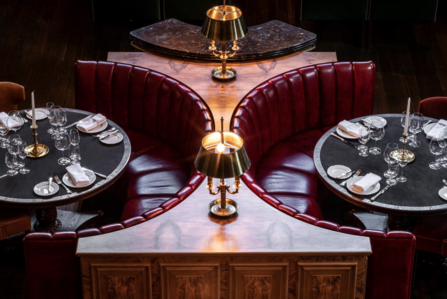
-
Decor and Style of the Restaurant
In the competitive world of dining experiences, decor, and style are crucial to determine what kind of furniture you should get. From theme and lighting to color schemes and artwork, every element contributes to the overall ambiance to attract customers and create a memorable dining experience for them.
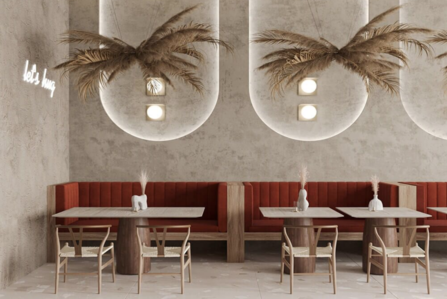
When selecting furniture for your restaurant, here are some decor and style considerations to make:
- Theme and Concept: Before diving into specific furniture shapes and colors, it’s crucial to establish a theme and concept for the restaurant. Whether it’s a rustic bistro, a contemporary cafe, or a trendy urban eatery, the theme sets the tone for all design decisions, including the furniture.
- Color Palette: The color palette of a restaurant has a profound impact on its atmosphere. Warm tones like earthy browns and reds can create a cozy and inviting ambiance, while cool tones like blues and greens evoke a more modern and refreshing feel. Harmonizing the color scheme with the theme and branding creates a cohesive and visually pleasing environment. Therefore, when choosing furniture, keep the color in mind.
- Lighting: Lighting is a powerful tool in setting the mood. If you want to keep the lights dim, you could go for bright-colored furniture to balance the environment. However, if you want to keep the lights as bright as possible, you can choose dark-colored furniture to create a perfect contrast. Some restaurants merge dim lights with dark-colored furniture to set the overall dark and dim tone, whereas some owners pair bright furniture with bright lighting to create a joyful, light atmosphere.
All the ways work. The key is to be consistent with your theme.
Considering Restaurant Space
Another factor to consider is what kind of space you are working with. Is it small and cozy? Do you have multiple floors? How many people can you accommodate at once? Ask yourself these questions when choosing furniture.
Heavy, bulky furniture, while more comfortable and exquisite, might take up more space. But you don’t also want to leave too much space that the place looks kind of incomplete
- What is the gap between a table and a chair in a restaurant?
It’s vital to leave a sufficient gap between a table and a chair in a restaurant for optimal legroom. The ideal gap is 10 to 12 inches between the seat of your chair and the underside of the tabletop. If the chair is movable, individual customers would be able to adjust it according to their preferred body postures.
For armchairs, you should leave at least a 6-inch gap between the armrests and the underside of the tabletop. This optimal gap facilitates proper seating arrangement, provides comfort, and accommodates smooth traffic flow.
Conclusion
Selecting the perfect restaurant furniture is a multifaceted process. It involves proper planning and careful consideration of a good number of factors—material, measurement, shape, style—which we’ve tried our best to shed light upon and help you make the right decision.
Besides the knowledge about different factors, it’s important to get some practical insights tailored to your restaurant as well to make a sensible decision. That is because striking a balance between aesthetics and practicality is the key to successful furniture choices.
Exotic Interiors Studio has helped restaurants all over Dubai create exceptional furniture choices. See our work for The Kebab Shop – TKA Lahore and Buffalo Boss – Jumeirah 1. We can assist you with your restaurant’s interior design as well.
Consult us today and transform your restaurant into a meaningful place with an interior that makes a statement.



